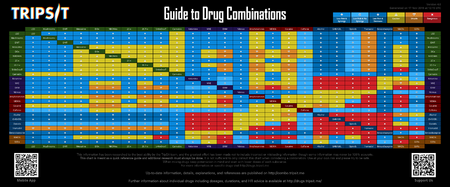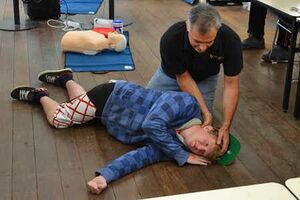Dangerous combinations
 |
This article is a stub. As such, it may contain incomplete or wrong information. You can help by expanding it. |
Although many drugs are safe on their own, they can become dangerous and even life-threatening when combined with other substances. Certain combinations may be safe in low doses of each but still increase the potential risk of death. Independent research should always be done to ensure that a combination of two or more substances is safe before consumption.

Drug related deaths most commonly occur when combining depressants. Depressants affect parts of the brain that are responsible for respiration, and an overdose or combination of these drugs can result in fatal levels of respiratory depression. Death may also occur when a victim falls into deep enough unconsciousness to suffocate from their own vomit. Lying in the recovery position can prevent one from inhaling their own vomit.

Another possibly fatal combination of drugs are serotonergic substances, which might cause serotonin syndrome. This can also be caused alone by an overdose of said substances. Serotonin syndrome is a result of excess serotonin in the brain, which can cause seizures, anxiety, tremors, nausea, coma and possibly a deadly fever. Usually this is caused when a user has used an anti-depressant within the last 2 weeks of consuming said drug. These kind of antidepressants include monoamine oxidase inhibitors (MAOIs), serotonin reuptake inhibitors (SSRIs) and serotonin–norepinephrine reuptake inhibitors (SNRI).
Depressants
Benzodiazepines
- Depressants (1,4-Butanediol, 2-methyl-2-butanol, alcohol, barbiturates, GHB/GBL, methaqualone, opioids) - This combination can result in dangerous or even fatal levels of respiratory depression. These substances potentiate the muscle relaxation, sedation and amnesia caused by one another and can lead to unexpected loss of consciousness at high doses. There is also an increased risk of vomiting during unconsciousness and death from the resulting suffocation. If this occurs, users should attempt to fall asleep in the recovery position or have a friend move them into it.
- Dissociatives - This combination can result in an increased risk of vomiting during unconsciousness and death from the resulting suffocation. If this occurs, users should attempt to fall asleep in the recovery position or have a friend move them into it.
- Stimulants - It is dangerous to combine benzodiazepines with stimulants due to the risk of excessive intoxication. Stimulants decrease the sedative effect of benzodiazepines, which is the main factor most people consider when determining their level of intoxication. Once the stimulant wears off, the effects of benzodiazepines will be significantly increased, leading to intensified disinhibition as well as other effects. If combined, one should strictly limit themselves to only dosing a certain amount of benzodiazepines per hour. This combination can also potentially result in severe dehydration if hydration is not monitored.
Thienzodiazepines
- Depressants (1,4-Butanediol, 2-methyl-2-butanol, alcohol, barbiturates, GHB/GBL, methaqualone, opioids) - This combination can result in dangerous or even fatal levels of respiratory depression. These substances potentiate the muscle relaxation, sedation and amnesia caused by one another and can lead to unexpected loss of consciousness at high doses. There is also an increased risk of vomiting during unconsciousness and death from the resulting suffocation. If this occurs, users should attempt to fall asleep in the recovery position or have a friend move them into it.
- Dissociatives - This combination can result in an increased risk of vomiting during unconsciousness and death from the resulting suffocation. If this occurs, users should attempt to fall asleep in the recovery position or have a friend move them into it.
- Stimulants - It is dangerous to combine thienzodiazepines with stimulants due to the risk of excessive intoxication. Stimulants decrease the sedative effect of thienzodiazepines, which is the main factor most people consider when determining their level of intoxication. Once the stimulant wears off, the effects of thienzodiazepines will be significantly increased, leading to intensified disinhibition as well as other effects. If combined, one should strictly limit themselves to only dosing a certain amount of thienzodiazepines per hour. This combination can also potentially result in severe dehydration if hydration is not monitored.
Opiates
- Depressants (1,4-Butanediol, 2m2b, alcohol, barbiturates, benzodiazepines, GHB/GBL, methaqualone) - This combination can result in dangerous or even fatal levels of respiratory depression. These substances potentiate the muscle relaxation, sedation and amnesia caused by one another and can lead to unexpected loss of consciousness at high doses. There is also an increased risk of vomiting during unconsciousness and death from the resulting suffocation. If this occurs, users should attempt to fall asleep in the recovery position or have a friend move them into it.
- Dissociatives - This combination can result in an increased risk of vomiting during unconsciousness and death from the resulting suffocation. If this occurs, users should attempt to fall asleep in the recovery position or have a friend move them into it.
- Stimulants - It is dangerous to combine oxycodone, a depressant, with stimulants due to the risk of excessive intoxication. Stimulants decrease the sedative effect of oxycodone, which is the main factor most people consider when determining their level of intoxication. Once the stimulant wears off, the effects of oxycodone will be significantly increased, leading to intensified disinhibition as well as other effects. If combined, one should strictly limit themselves to only taking a certain amount of oxycodone.
Serotonergic drugs
| This section is empty. You can help by adding to it. |
Other
| This section is empty. You can help by adding to it. |
See also
- Responsible drug use
- Recovery position
- Research chemicals
- Drug combination guide and chart (TripSit)